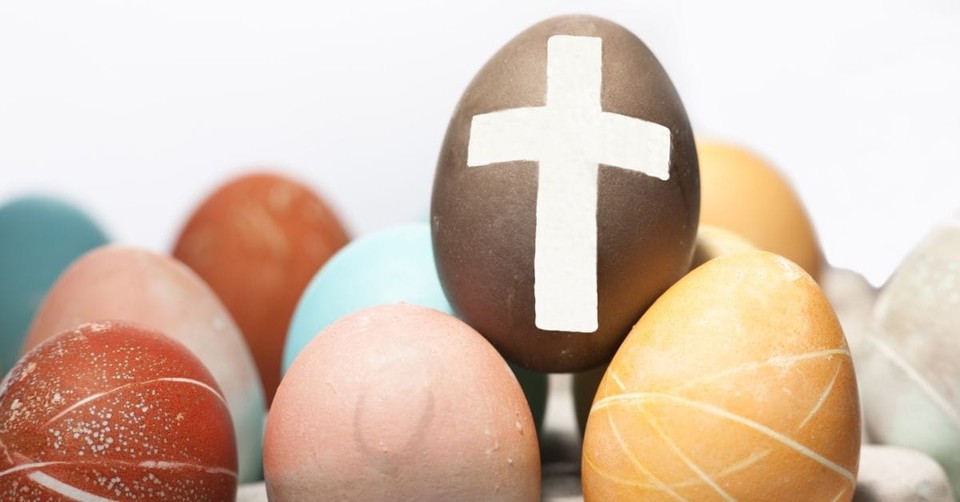Bring Christian History Alive through Easter Egg Traditions

As Easter approaches, your family may be one of the many families around the world that celebrates the holiday with eggs. Maybe you and your children will hard boil a carton of eggs and dye them a variety of bright colors. Perhaps you’ll eat the eggs afterward, display them in baskets, or hide them around your house or yard for your kids to find on an egg hunt. Or, you might buy plastic eggs and fill them with candy, then place those eggs in your children’s Easter baskets, use them for an egg hunt, or attend a community egg hunt where large groups of kids dash across fields to find plastic eggs with prizes hidden inside.
You all will likely have fun in the process. Many families today aim to simply have fun with Easter eggs, adding a bit of colorful joy to the holiday. But did you know that, by using eggs to celebrate Easter, you can do much more than just have fun? You can use Easter eggs to teach your children something profound: that they are part of a faith that connects all believers with God, whose Resurrection power can transform them.
Throughout Christian history, believers have celebrated a myriad of Easter egg traditions to express their faith in Jesus Christ’s Resurrection. Early Christians adopted the egg (which was previously a pagan symbol of new life that comes from nature’s cycles of renewal) as an Easter symbol because an egg’s hard shell represents Jesus’ sealed tomb, and cracking the shell symbolizes His Resurrection. Eggs, which often remind people of new life because some creatures are born from them, reminded early Christians that Jesus is the true source of new life spiritually – so they developed Easter traditions involving eggs.
Learning and practicing some of those traditions with your children can deepen their appreciation for the Easter story, Christian history, and their connection to the universal body of Christ. Here are some historical Easter egg traditions that you can celebrate with your kids this year:
Red eggs: Christians first began using eggs to celebrate Easter in ancient Mesopotamia, when they dyed eggs red – the color of blood – to symbolize the power of Jesus’ blood to give people new life. In some Orthodox churches, priests still bless red eggs during Paschal (Easter) vigil services on the night before Easter. You and your children can dye an entire group of eggs red rather than a variety of colors, and then discuss how Jesus loves people so much that He was willing to suffer and bleed on the Cross to pay the cost of our sins. You all can also use your red eggs to play a traditional Greek game called “Tsougrisma,” in which two players at a time each hold a red egg and crack their eggs together, trying to break their opponent’s egg without cracking their own. You and your kids can also prepare and eat an Easter snack from the Byzantine era: red eggs set within the folds of braided bread, which gives the impression of blood on the Cross.
Pysanky eggs: These elaborately decorated eggs reflect a style of art called “Pysanky” that originated in Eastern European countries such as Ukraine. Pysanky emphasizes writing or drawing on eggs with wax in between dyeing them different colors in progressively darker shades. Traditional Pysanky colors represent faith concepts that relate to Easter: white (purity), yellow (light and joy), orange (strength and endurance), red (the passion of Jesus on the Cross), green (hope and spiritual growth), blue (spiritual health), brown (Earth), and black (eternity). Also, traditional words (such as the phrase “Christ is Risen”) and pictures (like ladders, which represent prayer) used in Pysanky express concepts relating to Easter. Working with your kids to create layers of symbolic art on Pysanky eggs, you can discuss how God works in each of the different parts of their lives (from their relationships with family and friends, to their activities at church and school).
Egg symbols: You and your children can express your faith by drawing symbols on Easter eggs, as early Christians often did. Use either markers on white eggs or wax crayons on eggs you color afterward with dye (the part of the egg that you cover with wax will remain white when you dye it). Historical Easter egg symbols include: fish (Christianity), birds (hope), evergreen trees (eternal life), ribbons (eternal life), the sun and stars (spiritual growth), flowers (joy), triangles (the Trinity of the Father, Son, and Holy Spirit), and crosses (Jesus’ sacrifice for people’s sins).
Egg knocking: In this two-player game that has been popular with children and adults alike for many years of Christian history, the players each hold an Easter egg in their hands and knock them against their opponent’s egg while saying: “Christ is Risen!” The one whose intact egg breaks open the other egg is considered the winner, and the broken egg is symbolic of Jesus’ empty tomb on Easter morning. This game can get messy, but it can also be lots of fun for families to play together, with each family member taking turns playing against others.
Egg rolls: The tradition of rolling Easter eggs down hills began centuries ago in Europe as a way for children to celebrate how the stone that had sealed Jesus’ tomb rolled away on the day of His Resurrection. In the 18oos, one of the world’s most famous Easter egg rolls began: the one on the White House lawn (which first took place on the U.S. Capitol lawn), where children gather on the Monday after Easter to roll Easter eggs across the grass with spoons. Your family may choose to participate in a community egg roll if there’s one in your local area, or hold your own.
Easter egg trees: The hollow eggs that decorate Easter egg trees represent Jesus’ tomb, which became empty (hollow) on the first Easter after his Resurrection. The tradition of hanging the hollow shells of eggs on trees for Easter began in Germany and Austria centuries ago, and has recently become more popular in the United States. You and your children can create an Easter egg tree by making small holes with a knife or needle at the top and bottom of uncooked eggs to blow or drain out the yolk and white parts inside, then putting either ribbons or hooks through the top holes to attach the hollow eggs to the branches of a tree. If you’re short on time, you can substitute modern plastic Easter egg ornaments that are as easy to decorate with as Christmas tree ornaments. The tree you choose to decorate may either be a live one that’s growing outdoors, or a craft tree that is small enough to fit indoors.
Egg gifts: Early Christians often distributed eggs to the poor on Easter, and sometimes also to their family and friends. An ancient Irish Easter custom involves families counting out their eggs to give most of them to charity, and the rest to friends. You and your kids can pray for ideas about how you all can bless people you know with some type of snack or meal made with eggs around Easter. Once you decide what to make (anything from omelets to casseroles that features egg ingredients), you and your children can prepare and deliver it to people together.
Egg prayers: The custom of praying over Easter eggs goes back many years in Christian history. Early Christians sometimes offered simple prayers of gratitude to Jesus for making eternal life possible when they celebrated Easter with eggs. In 1610, when the Catholic Church declared the Easter egg an official symbol of the Resurrection, Pope Paul V prayed that God would bless people as they eat Easter eggs “… in thankfulness to You on account of the resurrection of the Lord.” A Protestant worship prayer known as “The Blessing of Eggs” asks God to: “Grant that they may be to us a sign of the new life and immortality promised to those who follow your Son, Jesus Christ our Lord.” You and your children can each offer your own heartfelt prayers to God while holding Easter eggs.
No matter which historical traditions your family chooses to try this year, you all can learn something that will help you better appreciate Jesus’ Resurrection and the rich history of how believers have celebrated it through the years.
Whitney Hopler, who has served as a Crosswalk.com contributing writer for many years, is author of the Christian novel Dream Factory, which is set during Hollywood's golden age. Her Twitter handle is @WhitneyHopler.
Publication date: April 4, 2014
Originally published April 04, 2014.




